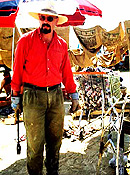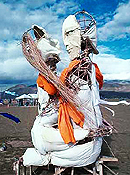In 1999, shortly after this exhibit the art department at Burning Man was created, and I became curator. For me, your basic art world dropout, Burning Man has connected me back to art in a way I can believe in, and in a context that I believe will have an impact on our notions of art making. It seems to me that we have a very limited way of thinking about the place of art in our lives today. One has to have a specific education to create the art, except for folk artists who are required not to have that education and who have also been co-opted by the art market. One has to have a certain kind of education to understand or appreciate the art. That leaves quite a lot of people out of the picture.
 Burning Man has in a sense given art back to the community. Participants don’t have to go into a museum or gallery to look at the art in a detached manner; they can help build it, they can touch it, and they can play with it. In a sense we have a sort of informal art school happening in the desert, as artists share information with those who have never created art. Recently I was talking with John Ricker, a local artist who founded a non-profit organization called Peaceful Streets – Guns into Art. John lectures about gun safety in the public schools and collects guns from the community. These guns are melted down or flattened and remade into public art pieces, which are then placed in community spaces. Often the guns are melted publicly at “gun bakes” and community members assist in the creation of art pieces. I had always assumed that John came out of a metal arts background, but he told me that in fact he comes from politics. He was at Burning Man several years ago and had been entertaining ideas about making art from gun metal, but had no idea how to go about doing it. He was talking with an artist on the playa about his quandary and the artist then spent nearly an hour walking John through the steps necessary to melt guns and cast them. John went back to San Francisco and did his first casting.
Burning Man has in a sense given art back to the community. Participants don’t have to go into a museum or gallery to look at the art in a detached manner; they can help build it, they can touch it, and they can play with it. In a sense we have a sort of informal art school happening in the desert, as artists share information with those who have never created art. Recently I was talking with John Ricker, a local artist who founded a non-profit organization called Peaceful Streets – Guns into Art. John lectures about gun safety in the public schools and collects guns from the community. These guns are melted down or flattened and remade into public art pieces, which are then placed in community spaces. Often the guns are melted publicly at “gun bakes” and community members assist in the creation of art pieces. I had always assumed that John came out of a metal arts background, but he told me that in fact he comes from politics. He was at Burning Man several years ago and had been entertaining ideas about making art from gun metal, but had no idea how to go about doing it. He was talking with an artist on the playa about his quandary and the artist then spent nearly an hour walking John through the steps necessary to melt guns and cast them. John went back to San Francisco and did his first casting.
 One doesn’t need an art degree to make art at Burning Man; in fact people who have never made a piece of art before can come out to the desert, create something in a public setting and be guaranteed an appreciative and responsive audience. This process has actually changed people’s lives, and each year we see better and better installations being made by people who never considered themselves artists. David Biggs, a graduate student at the University of Washington, studies irrigation systems in Viet Nam for part of the year. He did his first installation in 1999, “Dedication to Thich Quang Duc”, the monk who immolated himself in 1963 to protest the human rights abuses against Buddhists by the South Vietnamese. It was an altar constructed of stone with ceramic and wood fixtures laid out on a tatami mat. In 2000 he contributed a small installation to our theme art area, the Body. He built two life-size lanterns in the form of a man and a woman,
One doesn’t need an art degree to make art at Burning Man; in fact people who have never made a piece of art before can come out to the desert, create something in a public setting and be guaranteed an appreciative and responsive audience. This process has actually changed people’s lives, and each year we see better and better installations being made by people who never considered themselves artists. David Biggs, a graduate student at the University of Washington, studies irrigation systems in Viet Nam for part of the year. He did his first installation in 1999, “Dedication to Thich Quang Duc”, the monk who immolated himself in 1963 to protest the human rights abuses against Buddhists by the South Vietnamese. It was an altar constructed of stone with ceramic and wood fixtures laid out on a tatami mat. In 2000 he contributed a small installation to our theme art area, the Body. He built two life-size lanterns in the form of a man and a woman, 
positioned them in an embrace and titled them “The Shakti and Shiva Lanterns”.
It was a very simple, rather crudely made piece, but David was so inspired by his experience that he came back to us in 2001 with a much more accomplished installation, The Hanged One. Sited at the apex of Black Rock City, it was a large tree made of driftwood which David collected on the Olympic Peninsula in Washington from the Quilute Indian Nation, after they understood and approved of what he was doing. From the tree he suspended several orange and yellow silk lanterns which he had made by an upholsterer in Hanoi. In the tree he placed an altar containing objects typically found in VietNamese shrines, and the installation functioned as a meditative shelter for intrepid participants who ventured all the way to the trash fence on the topmost edge of our city. Some participants made the Hanged One their special place and appeared daily, staying for hours. Many people helped David construct the piece, and he felt richly rewarded by his efforts. “I feel I created an environment as well as an art sculpture that brought joy to several thousand people who made it out there. I found crowds of ten to twenty people in the mornings and evenings standing ten feet away and slowly rotating around the piece to look at it from all angles. Couples sat under the branches hidden by lanterns and talked or kissed. Some brave souls climbed inside the trunk to look at the tree from the inside out. People sat around and talked, stayed cool or enjoyed the soft light at two a.m. As with all my intended sculptures, this piece was a warm sanctuary far on the periphery of the event.”

